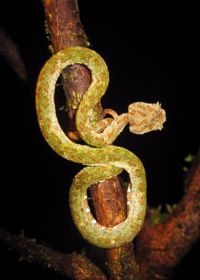The curious case of the disappearing snakes
A Michigan State University and University of Maryland-led study featured on the cover of this week's Science journal should sound alarm bells regarding the "biodiversity crisis" or the loss of wildlife around the world.
The loss of any species is devastating. However, the decline or extinction of one species can trigger an avalanche within an ecosystem, wiping out many species in the process. When biodiversity losses cause cascading effects within a region, they can eliminate many data-deficient species animals that have eluded scientific study or haven't been researched enough to understand how best to conserve them.
"Some species that are rare or hard to detect may be declining so quickly that we might not ever know that we're losing them," said Elise Zipkin, assistant professor in the Department of Integrative Biology and the Ecology, Evolution, and Behavior Program and the study's lead author. "In fact, this study is less about snakes and more about the general loss of biodiversity and its consequences."

The snakes in question reside in a protected area near El Copã, Panama. The new study documents how the snake community plummeted after an invasive fungal pathogen wiped out most of the area's frogs, a primary food source. Thanks to the University of Maryland's long-term study tracking amphibians and reptiles, the team had seven years of data on the snake community before the loss of frogs and six years of data afterwards.
Yet even with that extensive dataset, many species were detected so infrequently that traditional analysis methods were impossible. To say that these snakes are highly elusive or rare would be an understatement. Of the 36 snake species observed during the study, 12 were detected only once and five species were detected twice.
"We need to reframe the question and accept that with data-deficient species, we won't often be able to assess population changes with high levels of certainty," Zipkin said. "Instead, we need to look at the probability that this snake community is worse off now than it used to be."
Using this approach, the team, which included former MSU ecologists Grace DiRenzo and Sam Rossman, built statistical models focused on estimating the probability that snake diversity metrics changed after the loss of amphibians, rather than trying to estimate the absolute number of species in the area, which is inherently difficult because snakes are so rare.
"We estimated an 85 percent probability that there are fewer snake species than there were before the amphibians declined," Zipkin said. "We also estimated high probabilities that the occurrence rates and body conditions of many of the individual snake species were lower after the loss of amphibians, despite no other systematic changes to the environment."
Read more at MSU Today.



